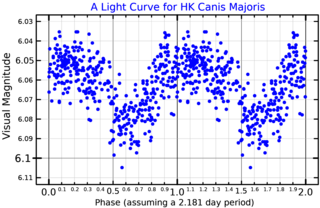
12 Canis Majoris is a variable star located about 707 light years away from the Sun in the southern constellation of Canis Major. It has the variable star designation HK Canis Majoris; 12 Canis Majoris is the Flamsteed designation. This body is just barely visible to the naked eye as a dim, blue-white hued star with a baseline apparent visual magnitude of +6.07. It is moving away from the Earth with a heliocentric radial velocity of +16 km/s. This is the brightest star in the vicinity of the open cluster NGC 2287, although it is probably not a member based on its proper motion.

HD 125823, also known as V761 Centauri or a Centauri, is a variable star in the constellation Centaurus. It is a blue-white star that is visible to the naked eye with a mean apparent visual magnitude of +4.41. The distance to this star is approximately 460 light years based on parallax measurements. It is a member of the Upper Centaurus–Lupus subgroup of the Scorpius–Centaurus association.
HD 113703, also known by the Bayer designation f Centauri, is a multiple star system in the southern constellation of Centaurus. The combined apparent visual magnitude of this system is +4.71, which is sufficient to make it faintly visible to the naked eye. The distance to this system is approximately 400 light years based on parallax measurements. It is a member of the Lower Centaurus Crux subgroup of the Scorpius–Centaurus association.
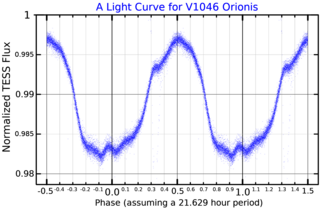
HD 37017 is a binary star system in the equatorial constellation of Orion. It has the variable star designation V1046 Orionis; HD 37017 is the identifier from the Henry Draper Catalogue. The system is a challenge to view with the naked eye, being close to the lower limit of visibility with a combined apparent visual magnitude of 6.55. It is located at a distance of approximately 1,230 light years based on parallax, and is drifting further away with a radial velocity of +32 km/s. The system is part of star cluster NGC 1981.

Chi Ophiuchi, Latinized from χ Ophiuchi, is a variable star in the equatorial constellation of Ophiuchus. It has a blue-white hue and is faintly visible to the naked eye with an apparent visual magnitude that fluctuates around 4.22. The distance to this object, as determined from parallax measurements, is approximately 500 light years, but it is moving closer to the Sun with a radial velocity of −19 km/s. This star is a proper motion member of the Upper Scorpius sub-group in the Scorpius–Centaurus OB association; the nearest such co-moving association of massive stars to the Sun.
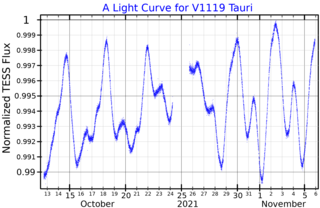
111 Tauri is a wide binary star system in the constellation Taurus. It is located at a distance of 48 light years from the Sun. Primary component A is a main sequence star with a stellar classification of F8V. The secondary component B is a K-type main sequence star. The primary is larger and more luminous than the Sun, with about 130% of the Sun's radius and 185% of the Sun's luminosity. The apparent magnitude of 5.0 indicates it is a faint star that can be viewed by the naked eye under good, dark-sky conditions.
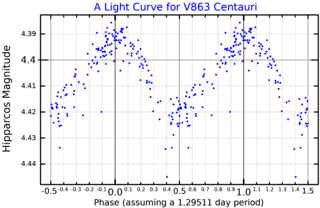
HD 105382 is a star in the constellation Centaurus. Its apparent magnitude is 4.47. From parallax measurements, it is located 130 parsecs from the Sun.
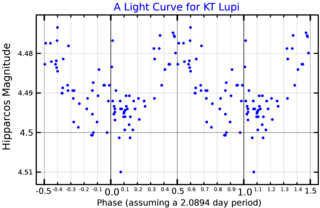
KT Lupi is a visual binary star system in the constellation Lupus. It is visible to the naked eye with a combined apparent visual magnitude of 4.55. As of 1983, the pair had an angular separation of 2.19″±0.03″. Based upon an annual parallax shift of 7.6 mas as seen from Earth's orbit, it is located 430 light-years from the Sun. The system is moving further from the Earth with a heliocentric radial velocity of +6.5 km/s. It is a member of the Lower Centaurus–Crux sub-group of the Scorpius–Centaurus association.
HD 143699 is a single star in the southern constellation of Lupus. It is a dim star but visible to the naked eye with an apparent visual magnitude of 4.90. Based upon an annual parallax shift of 9.2 mas, it is located around 350 light years away. It is most likely a member of the Upper Centaurus–Lupus subgroup of the Sco OB2 moving group.

HD 64740 is a single star in the southern constellation Puppis, positioned near the line of sight to the Gum Nebula. It has a blue-white hue and is faintly visible to the naked eye with an apparent visual magnitude of 4.63. Parallax measurements give a distance estimate of approximately 760 light-years from the Sun, and it is drifting further away with a radial velocity of +8 km/s.
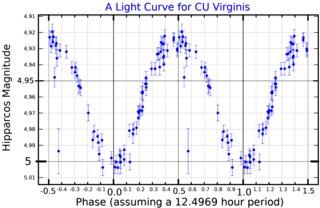
CU Virginis is a single star in the equatorial constellation of Virgo. It has an apparent visual magnitude of 4.99, which is bright enough to be faintly visible to the naked eye. The distance to this star can be estimated from its annual parallax shift of 13.9 mas, yielding a separation of 234 light years.
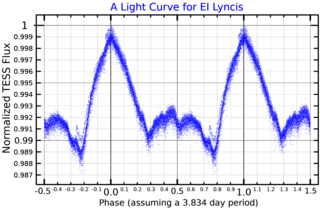
36 Lyncis is a solitary variable star located around 620 light years away from the Sun in the northern constellation of Lynx. It has the variable star designation of EI Lyncis, while 36 Lyncis is the Flamsteed designation. This object is visible to the naked eye as a dim, blue-white hued star with an apparent visual magnitude of 5.30. It is moving further away from the Earth with a heliocentric radial velocity of 21 km/s.
Theta Hydri, Latinized from θ Hydri, is the Bayer designation for a blue-white hued star in the southern constellation of Hydrus. It is faintly visible to the naked eye with an apparent visual magnitude of +5.53. Based upon an annual parallax shift of 6.50 mas as seen from Earth, is located approximately 502 light years from the Sun. At that distance, the visual magnitude of the star is diminished by an extinction of 0.10 due to interstellar dust. It is moving away from the Sun with a radial velocity of +12.3 km/s.
HD 142250 is a star in the constellation Scorpius. It has a visual apparent magnitude of 6.1, being visible to the naked eye only in excellent seeing conditions. From parallax measurements, it is located 486 light-years (149 parsecs) away from Earth. This distance, together with the star's proper motion, indicate that HIP 77900 is a member of the Upper Scorpius subgroup of the Scorpius–Centaurus association, the nearest OB association to the Sun. This subgroup is the youngest of the three of the association, with an estimated age of 11 million years.

V957 Scorpii is a variable star in the constellation of Scorpius. It is a blue straggler in the open cluster Messier 7, a star that is unexpectedly hot compared to other members of the cluster.
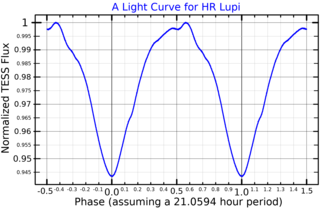
HD 133880, also known as HR 5624 and HR Lupi, is a Bp star about 340 light years from the Earth, in the constellation Lupus. It is a 5th magnitude star, and will be faintly visible to the naked eye of an observer far from city lights. It is an SX Arietis variable star, varying from magnitude 5.76 to 5.81 over a period of 21.0594 hours. HD 133880 is a member of the Upper Centaurus–Lupus association. It is a young star, estimated to have completed only 5±2 percent of its projected main sequence lifetime. It is one of the few stars known to produce coherent pulsed radio radiation via electron cyclotron maser emission.
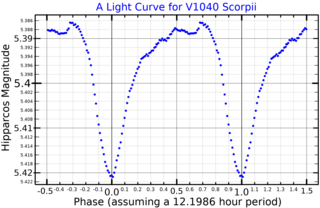
HR 5907, also known as V1040 Scorpii and HD 142184, is a star about 470 light years from the Earth, in the constellation Scorpius. It is a 5th magnitude star, so it will be faintly visible to the naked eye of an observer far from city lights. Its brightness varies slightly, ranging from magnitude 5.39 to 5.43 every 12 hours and 20 minutes. HR 5907 is a member of the Scorpius–Centaurus association.

HD 28843, also known as HR 1441 and DZ Eridani, is a star about 550 light years from the Earth, in the constellation Eridanus. It is a 5th magnitude star, so it will be faintly visible to the naked eye of an observer far from city lights. It is a variable star, whose brightness varies slightly from 5.70 to 5.84 during its 1.374 day rotation period. It is a member of the μ Tauri Association, a group of young stars within the larger Cassiopeia-Taurus Structure.
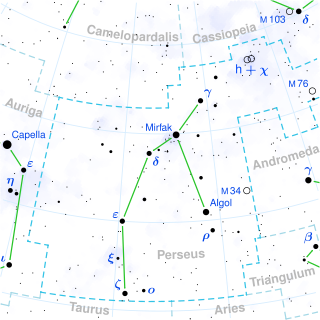
HD 21699, also known as HR 1063 and V396 Persei, is a star about 580 light years from the Earth, in the constellation Perseus. It is a 5th magnitude star, so it will be faintly visible to the naked eye of an observer far from city lights. This is a variable star, whose brightness varies slightly from 5.45 to 5.53 during its 2.4761 day rotation period. It has a remarkable dipole magnetic field which is displaced from the star's center by 0.4 stellar radii, the poles of which appear close to each other on the stellar surface. HD 21699 is a member of the Alpha Persei Cluster.

V686 Coronae Australis is a solitary, bluish-white-hued variable star located in the southern constellation Corona Australis. It has an apparent magnitude that ranges between 5.25 and 5.41, which makes it faintly visible to the naked eye. Gaia DR3 parallax measurements imply a distance of 480 light years and it is slowly receding with a heliocentric radial velocity of 1.3 km/s. At its current distance V686 CrA's average brightness is diminished by 0.35 magnitudes due to extinction from interstellar dust and it has an absolute visual magnitude of −0.24.
















